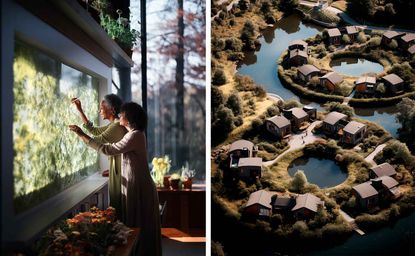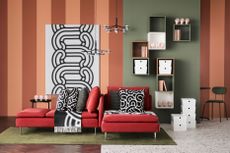Ikea Life at Home Report imagines life in 2030
The latest Ikea Life at Home Report includes imagined scenarios to paint a picture of the Swedish company’s predictions for how we will live in 2030

For over eight decades, Ikea has explored every facet of living, through collaborations with cutting-edge designers and institutions, and constant research into how daily lives can be improved by design. The Swedish giant just released its latest Life at Home Report, an annual compendium and an ongoing analysis of how we live.
'The Life at Home Report began in 2014, exploring the practical aspects of home, and over the years has expanded into the emotional landscape of where we live,' reads a note from the company introducing the 90-page report, a survey of 37,428 people across 38 countries. 'One of the most distinct qualities of the Life at Home Report is exploring how people feel about where they live, and not just what they do there. This blend of functional and emotional insights helped to develop a framework that presents eight emotional needs for a better life at home. This year, the research survey was based on the emotional needs of home.'
Ikea Life At Home Report: visions for future living

The productivity hub, where Jin lives in central Seoul – a work and life high-rise pod
'Based on the paths our lives are taking now, it’s possible to point to a number of certainties for our shared future,' reads the report. 'The difficult reality is that the road ahead is sure to be bumpy. We know that the climate crisis will continue to grow in scale and intensity, and it will impact all aspects of life – including where and how we live at home.'
Looking at how we will live at the end of this decade, Ikea imagined three scenarios, brought to life with the help with AI, reflecting on the uncertainties of the present and offering ways to 'depict a desirable role for the home in a volatile world'. The report presents three characters, each with unique life circumstances that guide their everyday behaviour and dwelling style.
Below, Ikea asks four questions that inspired its vision of the future.
What if there wasn’t just one home, but multiple homes to help people foster resilience and nurture themselves?

Jin uses an interactive globe used to plan travel routes, which makes suggestions on countries to visit that aren’t currently impacted by weather-related events
Jin lives in a pod in a high-rise apartment in central Seoul, a temporary living arrangement after climate reports proposed a temporary evacuation from the lowlands. Among his current plans is a graduation party in the building's breakout room (with guests attending both physically and remotely), and travelling with the help of a personalised AI advisor, who can check on visa and other requirements for moving across borders and facing extreme climate events. He also uses a headset, which 'helps with immersion, and he can access virtual environments that help him get into the feeling of travelling'.
In a few months, Jin is due to start a new job in experience design – his company's co-living programme will allow him to stay in pods all over the world.
Wallpaper* Newsletter
Receive our daily digest of inspiration, escapism and design stories from around the world direct to your inbox.
How can our homes foster our sense of identity and togetherness without alienating distinct communities from one another?

Angela working at the repair hub at the heart of a women-only housing collective featuring 3D printers and digital fabricators
The next future scenario sees Angela living in a women-only housing collective in Massachusetts, USA, working towards complete self-sufficiency. 'The group has designed a central workspace, which they call their She Shed, where they can repair almost anything in the collective,' explains the report. 'It’s where Angela will teach others to weld once she’s received her training at the technical college across the other side of the township.'
Angela's partner, Patricia, is learning how to deliver emergency medical treatment, while also helping 'fortify all the collective housing units against climate change'. Angela and Patricia's shared concern for climate change and interest in sustainable interior design have shaped their living arrangements, with bio-solar wallpaper that uses algae to generate electricity from sunlight, inspired by patterns from the early 2000s.
How might our relationship with technology and nature allow us to live with a more regenerative mindset?

Jamie's regenerated farmhouse in Uppsala, featuring solar panels, wind turbines, and drone monitored farmland with spectral measuring
Finally, Jamie is a non-binary primary school teacher, living with their two partners and children in a small township north of Uppsala, Sweden. To help with home management, the surfaces of the kitchen and all the floors are self-cleaning, and they can outsource meal planning and grocery shopping to the cloud.
As part of their routine, Jamie downloads a report from Gaia, the in-house AI that monitors energy use and overall wellbeing. Looking at data from climate and health forecasts, it makes suggestions including switching on the home's wind-ready turbines, or playing music to manage anxiety spikes.
The family 3D prints their own furniture from a mushroom compound and when visiting is not possible, spends time with relatives at virtual Sunday lunches and smaller online get-togethers. But Jamie also likes to move away from technology, by working on their adjacent land to reconnect with nature and earth.

Jamie and their children during AI-assisted story time
The homes depicted in these three scenarios support their residents from a practical and emotional perspective, enhancing the quality of their lives through technology that is unobtrusive and practical. They consider the fundamental roles of a home, making space for everyday essentials, regular connections, meaningful moments and future plans.
'It’s significant to see the impact of climate change on life at home as we know it,' says Mat Lincez, Foresight Director for Human Futures Studio. 'But there is careful optimism, with technology helping us live more sustainably. We will need a shift towards new ways of powering our world, as well as emerging techniques for distributed manufacturing. These scenarios also emphasise the role of relationships between people: the shift towards co-operatives, community-centric lifestyles, and collective self-reliance can be a way to improve overall quality of life for everyone.'
He continues: 'I’m curious to see how Ikea can support when “home” becomes a relative term in the wake of increased mobility. Being able to quickly establish a home environment and social connections will be vital in these uncertain circumstances.'

An immersive, virtual karaoke session at Jin's, with friends who can’t join in person

Jamie 3D printing furniture from a mushroom compound
Rosa Bertoli was born in Udine, Italy, and now lives in London. Since 2014, she has been the Design Editor of Wallpaper*, where she oversees design content for the print and online editions, as well as special editorial projects. Through her role at Wallpaper*, she has written extensively about all areas of design. Rosa has been speaker and moderator for various design talks and conferences including London Craft Week, Maison & Objet, The Italian Cultural Institute (London), Clippings, Zaha Hadid Design, Kartell and Frieze Art Fair. Rosa has been on judging panels for the Chart Architecture Award, the Dutch Design Awards and the DesignGuild Marks. She has written for numerous English and Italian language publications, and worked as a content and communication consultant for fashion and design brands.
-
 ‘There are hidden things out there, we just need to look’: Studiomama's stone animals have quirky charm
‘There are hidden things out there, we just need to look’: Studiomama's stone animals have quirky charmStudiomama founder's Nina Tolstrup and Jack Mama sieve the sands of Kent hunting down playful animal shaped stones for their latest collection
By Ali Morris Published
-
 Tokyo firm Built By Legends gives fresh life to a performance icon, Nissan’s R34 GT-R
Tokyo firm Built By Legends gives fresh life to a performance icon, Nissan’s R34 GT-RThis Japanese restomod brings upgrades and enhancements to the Nissan R34 GT-R, ensuring the cult of the Skyline stays forever renewed
By Jonathan Bell Published
-
 Squire & Partners' radical restructure: 'There are a lot of different ways up the firm to partnership'
Squire & Partners' radical restructure: 'There are a lot of different ways up the firm to partnership'Squire & Partners announces a radical restructure; we talk to the late founder Michael Squire's son, senior partner Henry Squire, about the practice's new senior leadership group, its next steps and how architecture can move on from 'single leader culture'
By Ellie Stathaki Published
-
 Rescue dogs and cats model Ikea's latest pet collection
Rescue dogs and cats model Ikea's latest pet collectionIkea Utsådd pet collection features cats and dogs essentials, modelled in their latest catalogue by rescue pets from the Woodgreen Pets Charity
By Rosa Bertoli Published
-
 Ikea meets Japan in this new pattern-filled collection
Ikea meets Japan in this new pattern-filled collectionNew Ikea Sötrönn collection by Japanese artist Hiroko Takahashi brings Japan and Scandinavia together in a pattern-filled, joyful range for the home
By Rosa Bertoli Published
-
 Ikea introduces its first gaming furniture collection
Ikea introduces its first gaming furniture collectionBrännboll is the first Ikea gaming furniture collection, unveiled during Milan Design Week 2024 and designed to swiftly transform a domestic space into a gamer’s paradise
By Jasper Spires Published
-
 Ikea and Raw Color deliver a collection of vibrant crafts to cheer up your living space
Ikea and Raw Color deliver a collection of vibrant crafts to cheer up your living spaceIkea and Raw Color present ‘Tesammans’, a collection full of playful designs, vibrant textures and an eye-catching colour palette
By Yoko Choy Published
-
 Designing for Ikea: Gio Tirotto on the process of creating an Ikea chair
Designing for Ikea: Gio Tirotto on the process of creating an Ikea chairThe first Italian designing for Ikea, Gio Tirotto tells Wallpaper* about the process of creating furniture for the most democratic design company
By Maria Cristina Didero Published
-
 2024 horoscope: design for every star sign
2024 horoscope: design for every star signFor the Wallpaper* 2024 horoscope, we asked Italian astrologist Lumpa what the year has in store, and what design objects each star sign will love
By Lumpa Published
-
 Ikea Dajlien marks the company's home wellness and training equipment debut
Ikea Dajlien marks the company's home wellness and training equipment debutDuring Miami Art Week 2023, Ikea presented the Dajlien collection, comprising 19 new wellness products and marking the Swedish company's training equipment debut
By Maria Sobrino Published
-
 Ikea’s Space10: a decade of ground-breaking design ideas
Ikea’s Space10: a decade of ground-breaking design ideasIkea’s Space10 has announced it will close on 31 August 2023 after ten years of groundbreaking innovations in food, design and more: see our Space10 top ten
By Rosa Bertoli Published